- Types of Sailboats
- Parts of a Sailboat
- Cruising Boats
- Small Sailboats
- Design Basics
- Sailboats under 30'
- Sailboats 30'-35
- Sailboats 35'-40'
- Sailboats 40'-45'
- Sailboats 45'-50'
- Sailboats 50'-55'
- Sailboats over 55'
- Masts & Spars
- Knots, Bends & Hitches
- The 12v Energy Equation
- Electronics & Instrumentation
- Build Your Own Boat
- Buying a Used Boat
- Choosing Accessories
- Living on a Boat
- Cruising Offshore
- Sailing in the Caribbean
- Anchoring Skills
- Sailing Authors & Their Writings
- Mary's Journal
- Nautical Terms
- Cruising Sailboats for Sale
- List your Boat for Sale Here!
- Used Sailing Equipment for Sale
- Sell Your Unwanted Gear
- Sailing eBooks: Download them here!
- Your Sailboats
- Your Sailing Stories
- Your Fishing Stories
- Advertising
- What's New?
- Chartering a Sailboat
- Sail Dimensions

What Sail Dimensions are Required to Calculate Sail Areas?
The required sail dimensions for calculating the area of any triangular sails are usually its height and the length of its foot. But that only works for mainsails and mizzens with no roach, and jibs with a 90 degree angle at the clew - and what about high-cut headsails, spinakers and cruising chutes? Read on...
Foresail and mainsail dimensions are universally referenced with the letters 'J', 'I', 'E' and 'P' approximating to the length of the foredeck, height of the mast, length of the boom and the height of the main sail - but more accurately defined further down this page.
Yacht designers need these sail dimensions to calculate thought provoking stuff such as the sail-area/displacement ratios of their creations, and sailmakers need them before they put scissors to sailcloth.
If our sailboat's sails were perfectly triangular then, as every schoolboy knows, their area would be 'half the height, times the base' - but with the possible exception of a mainsail with a straight luff, generally they're not. Here's how it works...
Main and Mizzen Sail Dimensions
These are almost right-angled triangles except for the curvature of the leach (the 'roach') which increases the sail area.
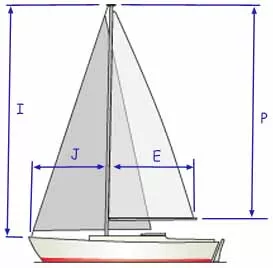
It's usually calculated as:~
Area = (luff x foot)/1.8, or
Area = ( P x E )/1.8, where:~
- 'P' is the distance along the aft face of the mast from the top of the boom to the highest point that the mainsail can be hoisted, and
- 'E' is the distance along the boom from the aft face of the mast to the outermost point on the boom to which the main can be pulled.
For the mizzen sails on ketches and yawls , 'P' and 'E' relate to the mizzen mast and boom.
For more heavily roached sails, the increased area can be accounted for by reducing the denominator in the formula to 1.6.
Clearly calculating sail areas isn't going to be an exact science...
Jibs, Genoas and Staysail Dimensions
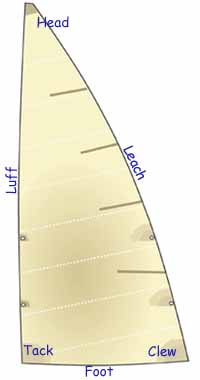
For a working jib that fills the fore triangle - but no more - and with a foot that's parallel to the deck, then you've got a 'proper' right-angled triangular sail, whose area is:~
Area = (luff x foot)/2, or
Area = ( I x J )/2, where:~
- 'I' is the distance down the front of mast from the genoa halyard to the level of the main deck, and
- 'J' is the distance along the deck from the headstay pin to the front of the mast.
Genoas, by definition, have a clew which extends past the mast and are described by the amount by which they do so. For instance a 135% genoa has a foot 35% longer than 'J' and a 155% genoa 55% longer. Areas are calculated as follows:~
Area (135% genoa) = (1.44 x I x J )/2, and
Area (155% genoa) = (1.65 x I x J )/2
High-cut Headsails
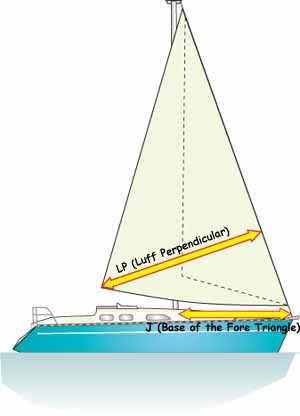
But these formulae don't work for a high-cut jib with a raised clew - unless you imagine the sail turned on its side such that the luff is the base and the luff perpendicular is the height.
It's still a simple calculation though, once you know the length of the luff perpendicular ( LP ), the sail area is:~
Area = (luff x luff perpendicular)/2, or
Area = ( L x LP )/2, where:~
- 'L' is the distance along the forestay from the headstay pin to the front of the mast, and
- 'LP' is the shortest distance between the clew and the luff of the genoa.
Spinnaker Sail Dimensions
Much like calculating foresail areas, but with different multipliers for conventional spinnakers and asymmetric spinnakers...
Conventional Spinnakers
Area = (0.9 x luff x foot), or
Area = (0.9 x I x J ), where:~
- 'I' is the distance from the highest spinnaker halyard to the deck, and
- 'J' is the length of the spinnaker pole.
Asymmetric Spinnakers
Area = (0.8 x luff x foot), or
Area = (0.8 x I x J ), where:~
- 'I' is the distance from the highest spinnaker halyard to the deck, and
- 'J' is the distance from the front face of the mast to the attachment block for the tackline.
More about Sails...

Are Molded and Laminate Sails One Step Too Far for Cruising Sailors?
Although woven sails are the popular choice of most cruising sailors, laminate sails and molded sails are the way to go for top performance. But how long can you expect them to last?
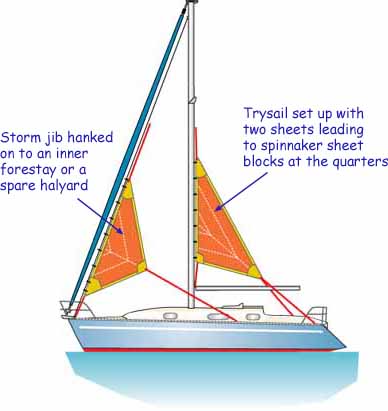
Is Carrying Storm Sails on Your Cruising Boat Really Necessary?
It's good insurance to have storm sails available in your sail locker if you are going offshore, and these are recommended fabric weights and dimensions for the storm jib and trysail
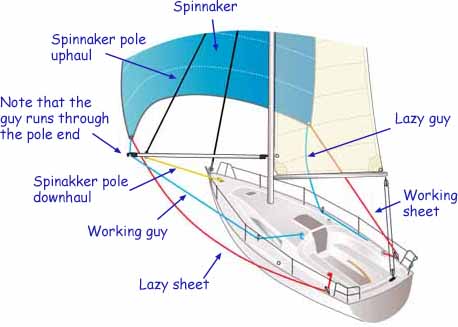
Using Spinnaker Sails for Cruising without the Drama!
When the wind moves aft and the lightweight genoa collapses, you need one of the spinnaker sails. But which one; conventional or asymmetric? Star cut, radial head or tri-radial?

The Mainsail on a Sailboat Is a Powerful Beast and Must Be Controlled
Learn how to hoist the mainsail, jibe it, tack it, trim it, reef it and control it with the main halyard, the outhaul, the mainsheet and the kicker.

Is Dacron Sail Cloth Good Enough for Your Standard Cruising Sails?
Whilst Dacron sail cloth is the least expensive woven fabric for standard cruising sails, do the superior qualities of the more hi-tech fabrics represent better value for money?
Recent Articles
Moody 346 for Sale
Aug 19, 24 03:33 PM
Used Sailing Equipment For Sale
Aug 18, 24 02:29 AM
Atlantic 49 Sailboat: Specs and Data
Aug 17, 24 03:08 PM
Here's where to:
- Find Used Sailboats for Sale...
- Find Used Sailing Gear for Sale...
- List your Sailboat for Sale...
- List your Used Sailing Gear...
Our eBooks...

A few of our Most Popular Pages...

Copyright © 2024 Dick McClary Sailboat-Cruising.com

By Product Categories
Small Boat Blocks
Big Boat Blocks
Complementary Hardware
Travelers & Genoa Leads
Mainsail Handling
Headsail Handling
Mooring Solutions
Spare Parts
Accessories
Harken Canvas
Sportfishing
Fly Soft-Attach Blocks
Carbo Air Blocks
Small Boat Classic
Flip-Flop Small Boat
GP Catamaran Ceramic Mainsheet Systems
Protexit™ Exit Blocks
Through-Deck
Wire High-Strength
Dinghy Vang
Small Boat Deck Organizers
Midrange Classic
Midrange Deck Organizers
Zircon Blocks
Element Blocks
Black Magic Air Blocks
Cruising ESP Blocks
Megayacht Blocks
Stainless Steel Blocks
Black Magic Air Runners
FlatWinder Powered Blocks
Mastbase Blocks
Over-the-Top
Crossover Blocks
Big Boat Deck Organizers
Cam Cleats & Kits
Cam Cleat Accessories
Cam Cleat Bases
Stand-Up Bases
Deck Organizers
Spinnaker Pole Cars
Soft Attachments
Fixed Padeyes
Removable Padeyes
Bolt-Down Fairleads
Grand Prix Jib Leads
Halyard Tensioners
Tiller Extensions
Peter's Desk Drawer
Dinghy Jib Leads
Crossbow Pivoting Self-Tacking Jib Traveler
13 mm Micro
22 mm Small Boat
27 mm Midrange
32 mm Big Boat
Windward Sheeting
42 mm Mini-Maxi
T-Track Genoa Lead
Access Rail System
13 mm AA Battcar System
22 mm A Battcar System
27 mm B Battcar System
32 mm C Battcar System
18 mm Switch Battcar System
26 mm Switch Battcar System
26 mm Trysail Switch
32 mm Switch Battcar System
32 mm Trysail Switch
40 mm Switch Battcar System
40 mm Trysail Switch System
Furling Mainsail Outhaul Systems
Single Line Reefing
Harken Vang-Master
Carbo Racing Foil
Small Boat Furling
Small Boat Underdeck
Reflex Furling
MKIV Jib Reefing & Furling
MKIV Underdeck Jib Reefing & Furling
Furling Accessories
Powered Furling
MKIV Ocean Furling
SnubbAir (Not a Winch)
Grand Prix Winches
Air Winches
Circuit Breakers
Analog Switches
Digital System Switch
Aluminum, Chrome & Bronze Winch Handles
Carbo OneTouch Locking Winch Handle
Service Kits
CLR Mooring Winches
Electric Captive Reel Winches
Hydraulic Captive Reel Winches
UniPower Radial
Single-Acting Integral Backstay Adjuster
Single-Acting Cylinders
Locking Cylinders
Double-Pull Cylinders
Grand Prix Cylinders
Hydraulic Cylinder Rod End Blocks
Hydraulic Cylinder End Fittings
Control Valves
Control Manifolds
Control Panels
Compact Control Panel
Rotary Pumps
Hydraulic Pump Handles
Power Systems
Repair Kits
Ball Bearings
Block Spare Parts
Traveler Cars
Furling Spare Parts
Winch Spare Parts
Winch Service Kits
Blockheads Gear
Promo & Gifts
Marine Grip
Blue Performance
Jeep/Truck tops
Garage storage
One-design Covers
Boat accessories
Canvas bags
By Type of Sailing
Dinghy / One-Design
Offshore Racing
Coastal / Day Cruising
Bluewater Cruising
Megayachts / Custom
Service Guide
Tech/Service
deck layouts
Data Sheets (SDS)
How to choose
System diagrams
Calculators
Reeving diagrams
Traveler Purchase Selection Guide
How to Choose
Testimonials
Hoister Videos
Request a Quote
Request Samples
Fabric details
Cover Styles
Canvas Videos
Contract Services
Materials and Components
Our Equipment
Contract Cut-and-Sew Project Spotlight
- Harken at the front
- Safety & Rescue
Support / Tech/Service Articles
Rig Dimensions
The following abbreviations are often used to describe various measurements on a sailboat. Precise technical definitions exist for each abbreviation, but the following is a list of simple descriptions.
| LOA | Length Overall - overall tip-to-tip length of the boat |
| LWL | Length Waterline - length of waterline of the boat |
| DWL | Design Waterline -theoretical waterline length of boat as opposed to LWL, which is actual waterline length |
| BMX | Beam Maximum - width of the boat at the widest point |
| BWL | Beam Waterline - widest beam of boat at the waterline |
| I | Height of the foretriangle measured from the top of the highest sheave to the sheerline |
| I2 | Height of staysail halyard above deck |
| J | Base of the foretriangle measured from the front of the mast to the intersection of the forestay and deck |
| J2 | Base of staysail triangle |
| P | Luff length of the mainsail |
| E | Foot length of the mainsail |
| LP | Shortest distance from headstay to the clew of the jib |
If you would like to link to or reprint this article please contact [email protected] .

Product Categories
- United States
- New Zealand
- United Kingdom
- BOAT OF THE YEAR
- Newsletters
- Sailboat Reviews
- Boating Safety
- Sails and Rigging
- Maintenance
- Sailing Totem
- Sailor & Galley
- Living Aboard
- Destinations
- Gear & Electronics
- Charter Resources
- Ultimate Boat Giveaway

How Sailboats Measure Up
- By By Jeremy McGeary
- Updated: October 17, 2012
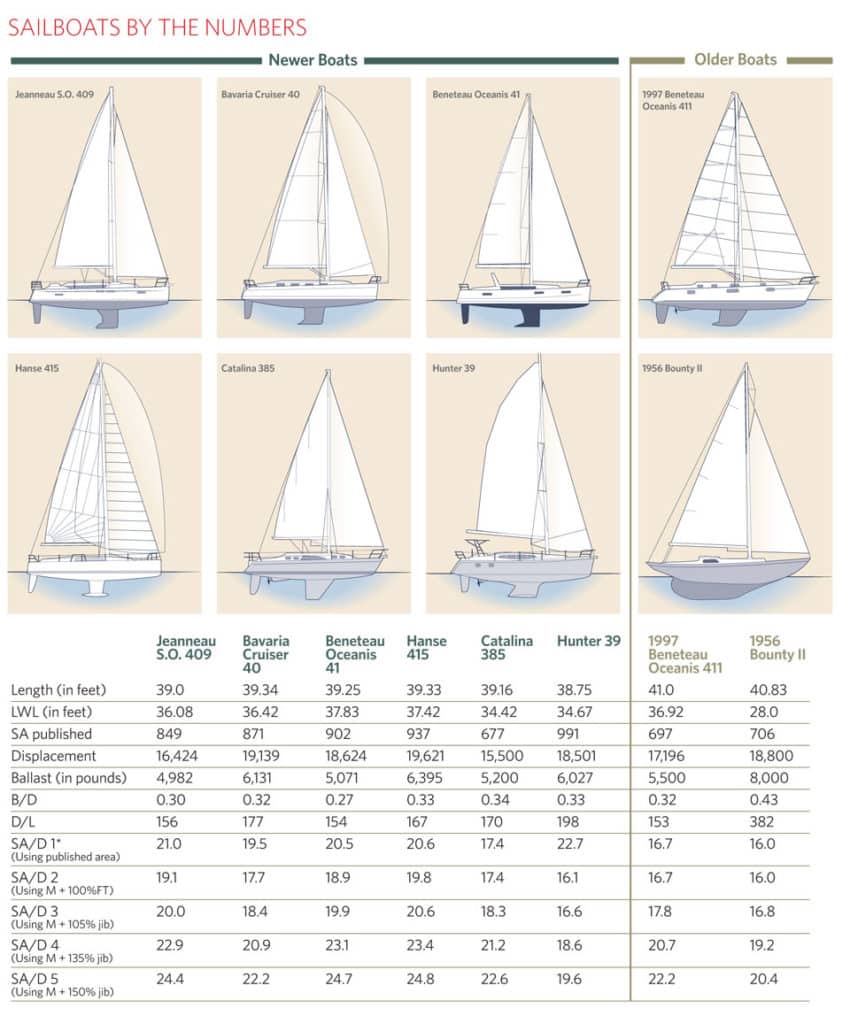
Sailboats by the Numbers
Boat reviewers rely on numbers to describe some of the key attributes of their subjects, such as length, beam, draft, and displacement. And while judgments on interior layouts and decor are subjective, these figures describing dimensions are not. There are, however, other numbers commonly cited in spec boxes that can prove more elusive, since they attempt to put a numerical value on how a sailboat might be expected to perform while under way. The commonly used ratios are sail area to displacement (SA/D), displacement to length (D/L), and ballast to displacement (B/D). And though they’re so commonly used that a certain amount of dogma has accrued around them, these figures can, in fact, be misleading, or at least misunderstood. And the result is that a boat can be assigned attributes based on numerical values that don’t take into account how sailboat design has changed over the past several decades.
Here, then, is a look at those ratios, what they attempt to describe, and how they should be interpreted when you go off exploring new and used models. (Click to page 2 for a more in-depth explanation.)
Sail Area/Displacement (SA/D)** An automobile buff seeking a high-performance ride looks for a high power-to-weight ratio and compares the horsepower/curb-weight ratios of different cars. For a sailboat, the SA/D provides the same metric. The horsepower comes from the wind on the sails and is proportional to the sail area; a boat’s weight is its displacement (in pounds, kilograms, or tons).
Initially, the SA/D only really gives a measure of potential acceleration rates (in case any physicists are reading this), but since displacement is a key factor in the resistance a boat encounters when moving through the water, SA/D also has a bearing on potential maximum speed.
The traditional calculation for SA/D compares sail area in square feet to displacement in cubic feet. In the formula, displacement in pounds is divided by 64 (the density of seawater) to obtain cubic feet, which are in turn converted to square feet to make the ratio unit-free.
On a spreadsheet, the formula would be S/(D/64) (2/3).
Nominally, the higher the SA/D, the more lively the boat’s sailing performance. The vessel will accelerate more quickly and have the potential for higher speed. But to be able to compare boats with any degree of precision (or fairness), we have to use similar numbers. The displacement must be in the same condition, either light ship (nothing on board) or fully loaded, and the sail-area measurement must reflect the normal working sail plan. Racing boats have measurement certificates from which these numbers can be reliably extracted. The specifications provided in cruising-boat brochures might not be consistent between builders, but we have to assume they are.
Boats measured in the 1970s and the 1980s for racing under the International Offshore Rule for the most part had SA/Ds between 16 and 17, based on the sum of the mainsail triangle (M = P E/2) and 100-percent foretriangle area (100%FT = I J/2). The measurement system favored small mainsails and large headsails, and since designers of cruising boats stuck close to the IOR sail plan, the IOR value for SA/D became the yardstick. An SA/D above 17 said “fast boat,” and anything below 16 said “slow boat.”
After the IOR fell out of favor, cruising-boat design drifted away from raceboat design, and sail plans began to change. Today, many boats are designed with large mainsails and small jibs, and most builders publish a “total sail area” number that includes the standard jib (often as small as 105 percent) and the roach in the mainsail (which is significantly greater on modern boats with full-battened mainsails than on IOR boats).
These builder-supplied numbers are more readily comparable against competing models, but using them in the SA/D formula makes the boats look “faster” than older models. This is a false comparison, because the sail area used for the older boats doesn’t include the extra area in, say, a 150-percent genoa.
The table “Sailboats by the Numbers” (see page 79) illustrates this. It shows SA/Ds calculated for a selection of modern boats and boats from past eras, all about the same length, using different numbers for sail area. For each model, it shows five SA/Ds. SA/D 1 is calculated using the sail area provided by the builder. SA/D 2 is calculated using M (P E/2) and 100% FT (I J/2). SA/D 3 is calculated using M + 105% jib. SA/D 4 is calculated using M + 135% jib. SA/D 5 is calculated using M + 150% jib. The only SA/D that includes mainsail roach is SA/D 1.
Let’s look at some examples. The 1997 Beneteau Oceanis 411 has a published sail area of 697 square feet on a displacement of 17,196 pounds. That gives an SA/D 1 of 16.7 (the same as SA/D 2), which for decades was considered very respectable for a cruising boat.
In 2012, the current Beneteau Oceanis 41 has a published sail area of 902 square feet (453 mainsail + 449 jib) and a published displacement of 18,624 pounds, to give an SA/D 1 of 20.5. Wow! Super-high performance! But this is for the standard sail area, with the 449-square-foot jib (just about 100% FT and typical of the trend today toward smaller jibs that tack easily). Plug in the calculation using I, J, P, and E and SA/D 2 drops to 18.9 because it doesn’t include mainsail roach, which is about 16 percent of the total published mainsail area.
Go back to the 1997 model, tack on a standard-for-the-day 135-percent genoa, and the SA/D 4 becomes 20.7. (If we added in mainsail roach, typically about 11 percent of base mainsail area before full-battened sails, we’d have 21.4.) The 1997 boat has essentially the same horsepower as the 2012 model.
Looking at current models from other builders, the SA/Ds based on published numbers hover around 20, suggesting that designers agree on the horsepower a cruising sailboat needs to generate adequate performance to windward without frightening anyone.
The two boats in our chart that don’t at first appear to fit this model are the Hunter 39 and the Catalina 385, but they’re not really so far apart.
The Hunter’s SA/D 2 is 16.1. Its standard jib is 110 percent (327 square feet), and the rest of the published sail area is in the mainsail—664 square feet, of which 37 percent is roach!
Catalina is a little more traditional in its thinking. If you add the standard 135-percent genoa, the SA/D becomes 21.2—right in the ballpark. (It’s still there at 19.7 with a 120-percent genoa.)
The table shows that, for boats targeted at the “performance cruising” market, the SA/D numbers using actual sail area lie consistently around the 20 mark. To go above that number, you have to be able to fly that sail area without reefing as soon as the wind ripples the surface. To do that, you have to elevate stability—with broad beam, lightweight (i.e., expensive) construction, deep bulb keels, and fewer creature comforts.
Displacement/Length (D/L)** While sailboat builders and buyers are interested in displacement in terms of weight, naval architects view it as volume; they’re creating three-dimensional shapes. When working in feet, to get a displacement in pounds, they multiply cubic feet by 64, the density in pounds per cubic foot of seawater. (Freshwater boats displace more volume because the density of fresh water is only 62.4.) The D/L ratio is therefore a measure of immersed volume per unit of length—how tubby the hull is below the waterline.
According to conventional wisdom and empirical studies, the lower the D/L, the higher the performance potential. This is mainly due to wavemaking resistance being lower for slender hulls than for tubby hulls.
In the D/L formula, displacement in pounds is divided by 2,240 to convert it to tons to bring the values to manageable numbers, so D/L is displacement in tons divided by .01LWL (in feet) cubed.
In a spreadsheet, the formula would be D/(2240*(.01L)3), where D is the displacement in pounds and L is LWL in feet.
In the early days of fiberglass boats, the Cruising Club of America rule was the principal dictator of boat shapes. Because it was a waterline rule, designers kept waterlines short to keep ratings low and relied on long stern overhangs immersing to add “sailing length” when the boats heeled. Carbon fiber was available only to NASA, and boats had full interiors, so “light displacement” wasn’t really in the cards. A D/L of 300 was considered dashing, even risky. Many still-popular designs from the 1970s and 1980s have D/Ls as high as 400; see the Bounty II.
Fast-forward 40 years. Boats now have plumb bows and plumb sterns and waterlines almost as long as their LOAs—there are no rating penalties on a cruising boat. The boats’ weights haven’t changed much because, although builders try to save weight to save cost, the boats are so much bigger. The hull and deck surface areas are greater, and all that extra internal volume can be filled with furniture. The effect on D/L ratios has been drastic—just look at the table. A D/L ratio above 200 today describes a heffalump.
But do these lower D/Ls actually buy you any more speed? Yes and no.
Yes : Because speed is proportional to the square root of the waterline length. Today’s 40-footer has a much longer waterline than yesterday’s and ought to sail as fast as yesterday’s 50-footer. It might also benefit from reduced resistance due to a smaller cross-sectional area, but it also might have greater wetted-surface drag due to the longer immersed length. When sailing downwind in waves, though, the lower-D/L boat will surf more readily.
No : Because, as we saw above, the power-to-weight ratios (SA/D) of modern boats aren’t effectively any higher, and certainly aren’t in the realm that would allow our cruising sailboats to climb out of the displacement zone and plane. In most conditions, the lower-D/L boat is still trapped in its wave.
In the days of the IOR, a D/L of 250 was still pretty racy; see the 1978 Catalina 38. Today, even a D/L as low as 150 doesn’t make a boat a speedster if it can’t carry the sail area to make it so. To compete at a level with a Volvo 70, look for a D/L of about 40 and an SA/D of 65.
Ballast/Displacement (B/D)** The ballast/displacement ratio is simply the ballast weight divided by the boat’s total displacement. Since ballast is there to give the boat stability, it’s easy to jump to the conclusion that the higher the B/D, the stiffer the boat.
However, B/D doesn’t take into account the location of the ballast.
Take a boat that has a total displacement of 20,000 pounds and put its 8,000 pounds of ballast in the bilge. Now take the same boat and put the 8,000 pounds of ballast 4 feet deeper in a bulb at the bottom of a deep fin keel. Same ballast ratio (0.4), but very different stability.
When looking at B/D, therefore, we must ask about the configuration of the keel: How low is the ballast?
Stability analysis is complex and involves beam, hull cross-section, and length, among other factors, of which B/D is just one.
Since the late 1990s, builders of sailboats intended for sale in the European Union have been required to provide stability data, including a curve of righting arm at angles of heel from 0 to 180 degrees—far more information than anyone can divine from a B/D number and a much more useful measure of a boat’s inclination to stay upside down in the unlikely event (the way most people use their boats) that it exceeds its limit of positive stability.
CW contributing editor Jeremy McGeary is a seasoned yacht designer who’s worked in the naval-architecture offices of David Pedrick, Rodger Martin, and Yves-Marie Tanton and as a staff designer for Camper & Nicholson.
To read the related article, How To: Measure Sail Area, click here.
- More: boat design , How To
- More How To

Made for Shade: Cockpit Cover Options

Blackwater Wisdom for Holding Tanks

5 DIY Basics For Your Diesel Engine

Unraveling Efficiency: Diesel vs. Electric Propulsion

Off Watch: School Daze
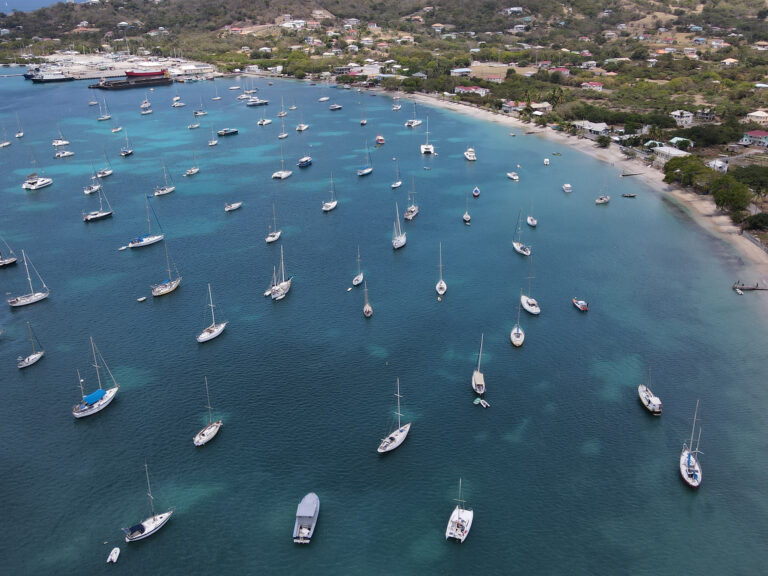
Paradise Pummeled
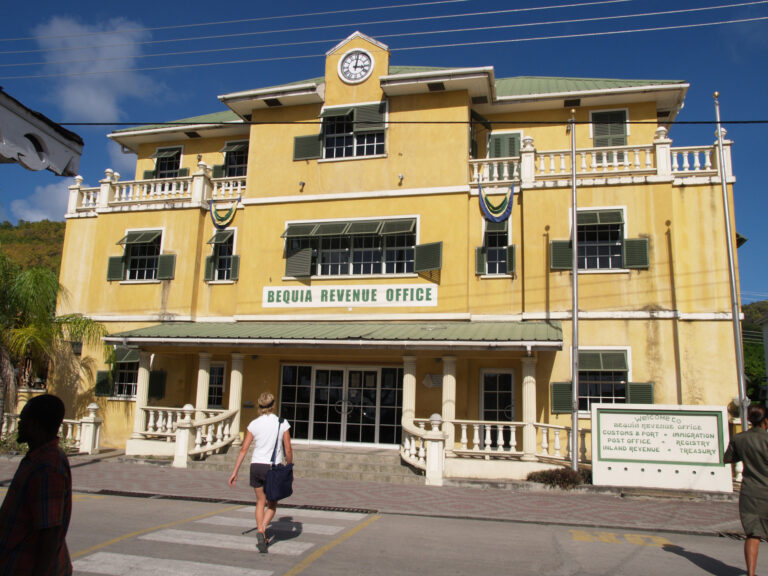
A Guide to Cruising Paperwork

A Superyacht Approach at Southerly Yachts
- Digital Edition
- Customer Service
- Privacy Policy
- Terms of Use
- Email Newsletters
- Cruising World
- Sailing World
- Salt Water Sportsman
- Sport Fishing
- Wakeboarding
The Worldwide Leader in Sailmaking
- Sail Care & Repair
- Sailing Gear
- Find A Loft
- Sail Finder
- Custom Sails
- One Design Sails
- Flying Sails
- New Sail Quote
- 3Di Technology
- Helix Technology
- Sail Design
- NPL RENEW Sustainable Sailcloth
- Sailcloth & Material Guide
- Polo Shirts
- Sweaters & Cardigans
- Sweatshirts & Hoodies
- Accessories
- Summer Sale
- Shop the look
- Mid & Baselayers
- Deckwear & Footwear
- Luggage & Accessories
- Spring Summer '24
- North Sails x 37th America's Cup
- Sailor Jackets
- SALT X North Sails
- NS x Slowear
- T-shirts & Tops
- Sailor Jacket
- Sustainability
- North Sails Blog
- Sail Like A Girl
- 37th America's Cup
- Icon Sailor Jacket
- Our Locations
- Certified B Corporation
- North SUP Boards
- North Foils
- North Kiteboarding
- North Windsurfing
SAIL FINDER
SAILING GEAR
COLLECTIONS & COLLAB
COLLECTIONS
WE ARE NORTH SAILS
ACTION SPORTS
Popular Search Terms
Organic cotton
Scuba fleece
Drawstring hood
Utility pocket
Stand collar
Sorry, no results for ""
Subscription
Welcome aboard.
We want to make our emails as relevant as possible for you.
Interests saved
Something went wrong, please try again
Welcome to North Sails
Stay up to date with the latest North Sails news.
Receive a 10% discount code for your first apparel order. Excludes sails and SUP’s. See our Terms and Conditions .
Yes, I agree to the terms of use and privacy policy.
SAIL PLAN DIMENSIONS
Figure out your rig dimensions when it comes to your sails.

The basic rig dimension for a yacht are generally understood. However, there are some differences in how some sailors describe these dimensions. Here is how we define them at North Sails.
I – Height of Foretriangle Elevation of Forestay, measured down to elevation of main shrouds at sheer line.
J – Base of Foretriangle Horizontal distance measured from front face of mast at deck to position of headstay at sheer line.
P – Mainsail Hoist Elevation of upper mast band or maximum main halyard position, measured down to lower mast band or top of boom.
E- Mainsail Foot Horizontal distance measured from aft face of mast at top of boom to boom band or maximum outhaul position.
Is – Height of Inner Foretriangle Elevation of Forestay, measured down to elevation of main shrouds at sheer line.
Js – Base of Inner Foretriangle Horizontal distance measured from front face of mast at deck to position of inner headstay at sheer line.
Py – Mizzen Mainsail Hoist Elevation of upper mast band or maximum main halyard position, measured down to lower mast band or top of boom.
Ey – Mizzen Mainsail Foot Horizontal distance measured from aft face of mizzen mast at top of boom to boom band or maximum outhaul position.
ISP – Elevation of Spinnaker Halyard Measured down to elevation of main shrouds at sheer line.
SPL – Spinnaker Pole Length
STL – Spinnaker Tack Length Horizontal distance measured from front face of mast at deck, forward and horizontally to position of spinnaker tack attachment point.

GET IN TOUCH
REQUEST A QUOTE
BROWSE ALL SAILS
FIND YOUR SAIL
Featured stories, offshore sailing guide, how to care for your foul weather gear, npl renew faq.
- Refresh page

My Cruiser Life Magazine
Working with Sail Dimensions
Why measure sails? Sailmaking is a complex discipline that blends elements of science and art. Perhaps you want to get a new set of sails made for your older boat, or perhaps you have a new to your boat with no sails to work from. However you attack the problem, you’ll have to start out with some measurements.
Table of Contents
Sail measurements and definitions, main sail dimensions, headsail dimensions — jib, genoa, or staysail, sails and sailing measurements made easy, sail dimensions faqs.

One thing to understand before diving in—sails are three-dimensional objects. You can lay them out flat on the ground, but a perfectly flat sail does not harness the wind. Instead, sails must have a curve built into them, and that makes measuring them much more complex.
The three sides of a triangular sail each have a particular name.
- Leech — The rear edge of a sail that is not attached to anything
- Luff — The forward edge of a sail, attached to the mast on a mainsail or to the stay on a headsail
- Foot — The lower edge of a sail, it runs along the boom on a mainsail
Likewise, each corner of a triangular sail has a name.
- Head — The top of a sail, where the halyard gets attached
- Tack — The forward corner, on a mainsail it gets attached to the gooseneck
- Clew — The aft corner, where the outhaul attaches on a main or the sheets attach to a jib
Sailboat Sail Dimensions
With those basic terms out of the way, it’s time to look at a few things that sailmakers consider when designing a set of sails. The most significant limits placed on the sailmaker come from the boat itself.
Many makes and models of boats have their sail specifications online. It’s essential to break out the tape measure and measure your boat–if only to confirm that the numbers you found are genuine. Remember, at this point, many of our sailboats have had long and storied lives well before we owned them. Your boat may have been custom rigged, and you don’t even know it.
Rig measurements also can change from year to year on one make and model as the manufacturer’s supplier changes. So you can’t be sure which numbers you find on the internet are correct and which apply to a different boat.
The limiting dimensions for mainsails are the height of the hoist along the mast and the length of the boom.
- P — distance along the aft face of the mast from the top of the boom (gooseneck) to the point of highest hoist at the maximum main halyard position
- E — distance along the boom from the mast to the maximum outhaul position
Mizzen Mainsail Hoist Elevation and Boom Length
Mizzen mast sails on ketches or yawls will have similar shapes and measurements as a mainsail. Therefore, their P and E measurements are usually denoted Py and Ey to show it is the mizzen sail.
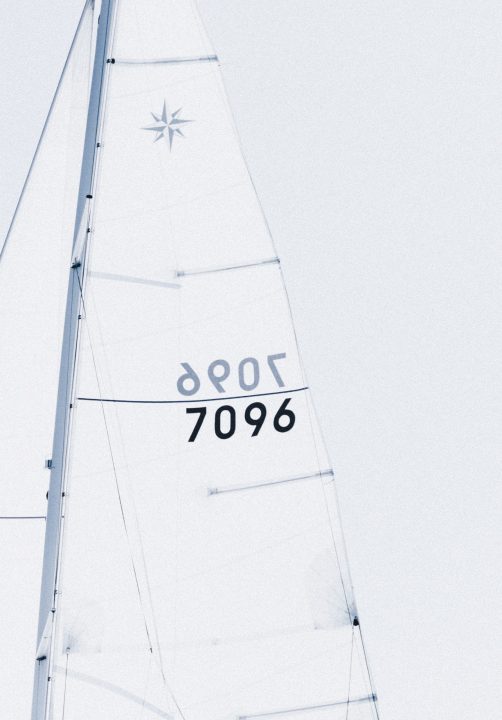
Main and Mizzen Sail Area Calculation
When given P and E, the unknown factor is the length of the sail’s leech. The leech can be longer and curve out, giving the sail more shape and lift by adding roach.
If the sail were perfectly flat, calculating its area would be straightforward. The area of a right triangle is equal to one-half of its two legs multiplied together.
Since the main or mizzen is not a flat object, though, we do not divide it by two (or halve it). Instead, we use a multiplier to estimate its area. For a regular mainsail, divide by 1.8. If the sail has a larger roach, divide by 1.6.
Mainsail Area = (P * E) /1.8
Mainsail Area (heavily roached sails) = (P * E) /1.6
The key measurements for a headsail are the distance up the mast that you can hoist the sail and the distance from the base of the headstay to the mast.
- I — The height along the front face of the mast from a point level with the headstay pin to the point of maximum hoist
- J — Foretriangle horizontal distance measured from he distance along the main deck, from the tack attachment to the mast
Headsail Area Sail Measurements
Assuming that the headsail is roughly a right triangle, the area equals those two sides multiplied together and divided by two.
Working Jib Area = (I * J) /2
However, it’s important to note that many genoas are designed to overlap the mast. Therefore, using the J measurement does not account for the extra sail area that projects aft of the mast.
135% Genoa Area = (1.44 * I * J) /2
155% Genoa Area = (1.65 * I * J) /2
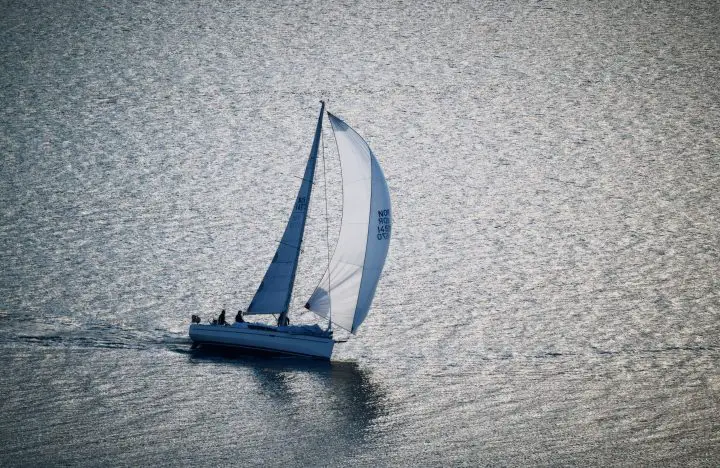
Luff Perpendicular
In the case of a high-cut jib or genoa that does not form a right triangle, the luff perpendicular measurement is used.
- L — (Luff) The distance of hoist from the attachment of the sail’s tack to the point of the maximum hoist, as measured on the forestay (i.e. the length of the sail’s luff)
- LP — (Luff Perpendicular) The shortest distance from the sail’s clew to the luff
The same area measurement formula applies.
High-cut Jib Area = (L * LP) /2
While it’s fun to work out all the specifications that set one boat apart from another, it’s of little use to the cruising sailor. Measuring sails is a simple task as long as you know what to look for and the limits that your boat places on your sails. Keep in mind that as long as a sail fits, it will probably work. Most sail lofts and second-hand sail dealers work on the “try and see” plan. So hoist the sail and give it a shot—you might be surprised.
How do you measure a sail?
Sails are measured based on the limitations presented on the boat. For example, a mainsail cannot be hoisted taller than the mast. So a critical measurement for a mainsail is the luff length, denoted by the measurement “P” in sail dimensions. Similarly, you cannot mount a mainsail on a boom that is too short. So the foot of a mainsail is denoted as “E.”
What is sail size?
Sails are sized based on the fixed dimensions from the boat they are made for. In other words, nearly every sail is custom-tailored to the rig on the boat. You can take specific measurements from the rig that will dictate the size of the final sails. Within those boundaries, sailmakers can tinker with a few other ways to add sail area, like adding roach to mainsails or creating overlapping headsails.
How are sail luffs measured?
The luff of a sail determines its draft, or how much curve the sail has. As such, there is no straight-line measurement for the luff of a sail. Instead, sailmakers used the fixed measurements from the leech and foot of the sail to determine its overall size. The luff, in the end, may be curved outward to add roach and more draft.
Too much luff is not a good thing, however. If the luff is too long on a mainsail, the boom may sit too low to clear the bimini, hardtop, or boom gallows.

What is the formula of sail?
The area of a sail is calculated by multiplying the luff or vertical by the foot and dividing by 1.8 for mainsails or 2 for headsails. Mainsail or Mizzensail Area = (P * E) /1.8 Jib, Genoa, or Staysail Area = (I * J) /2
Matt has been boating around Florida for over 25 years in everything from small powerboats to large cruising catamarans. He currently lives aboard a 38-foot Cabo Rico sailboat with his wife Lucy and adventure dog Chelsea. Together, they cruise between winters in The Bahamas and summers in the Chesapeake Bay.

- Measurements
On this page
Measurement is a fundamental part of any rating system. In order to have a boat's rating calculated, the boat’s characteristics need to be defined by taking the measurement of all parts that affect the boat's performance. The International Measurement System (IMS) is a set of rules that defines what and how is measured on the boat. By using IMS, the complete boat can be measured, including the hull shape, appendages, propeller, stability, rig and sails. IMS uses WS Equipment Rules of Sailing (ERS) and its definitions are amended only for items specific to offshore boats. Same measurement procedures may be used in measurements of monohulls, multihulls or superyachts.
Measurements procedures explained in this section are for information and description only. Complete measurement rules can be found in the IMS Rule book.
Boats shall be measured by official measurers as appointed by the National Sailing Authorities. Use of ERS makes use of IMS easy for measurers of other international classes, while for parts specific to offshore boats and measurement principles in general, ORC regularly organizes measurement seminars.
How boat shall be prepared for the measurement?
Boats shall be measured dry in light ship condition without crew. Items on board include:
- Internal ballast, if any
- Fixed and/or essentially permanent interior accommodation, hatch covers and floor boards
- Fixed and/or essentially permanent machinery, electrical and plumbing systems.
- Mast, boom, spinnaker pole and/or bowsprit with standing rigging and fittings
- Any appendages including rudder, keel, centerboard, bilge board or any other foils
- All fixed electronics, instruments, compasses, lights, antennas and masthead devices.
- Pulpits, stanchions and lifelines.
- Mattresses and permanently installed table, doors on their normal position.
- Permanently installed stoves, heaters or other electrical devices.
Specifically excluded from the measurement trim are the following:
- Water and any liquid contents of any tanks or voids in the keel or other appendages
- Anchor and anchor lines
- Deck and mooring lines
- Any sails, including storm and emergency sails
- Sheets, blocks, winch handles
- All portable safety gear
- Cushions, pillows and any other bedding
- Cooking and eating utensils
- Any food or stores
- Miscellaneous portable and personal gear, books, navigational tools etc.
An easy explanation of lightship measurement trim would be that if the boat is rotated upside down, everything that falls out shall not be on board.
How the compliance with the certificate is defined?
All measured, declared or recorded values shall be as close as possible to those on the certificate. Differences are allowed only if the values on the certificate give a faster rating. The sail area shall be smaller or equal to that printed on the certificate.
The sails inventory of the monohulls shall include the largest of each when on board:
- quadrilateral sail or sail set on the wishbone boom
- headsail set on the forestay
- symmetric spinnaker, asymmetric spinnaker
- mizzen staysail
- all headsails set flying
- all asymmetric spinnakers having SHW/SFL < 0.85.
While sails inventory on the multihulls and superyachts shall include all sails on board.
Values declared by the owner such as crew weight or use of asymmetric spinnaker tacked only on the centerline shall not be considered as an issue of compliance with the certificate, and shall always follow appropriate rules.
Offshore Racing Congress Partners

Log in to ORC Sailor services using email and password
ORC Sailor Services allows you access to ORC Database of all ORC certificates issued worldwide such as accessing speed guides, target speeds and do test runs on any certificate.
ORC Sailor Services - Password reminder
Please enter the e-mail address registered for the ORC Sailor Services to receive your password
ORC Sailor Services
With an ORC Certificate you are getting more than just a rating. ORC Sailor Services allows you access to the ORC Database of all ORC certificates issued worldwide.
Home > Resources > Rig Specification Diagram For Sailboats: Mainsail & Headsail
Rig Specification Diagram For Sailboats: Mainsail & Headsail
30 December 2020
Ask Precision Sails , Design , Featuring - Partners , Headsail , Mainsail , Measurements , Sails , Technical Tags: Furling , Headsail , Mainsail , Precision Sails , rig , Sails , Specifications , Specs
Sailboat Rig Specs: Precision Sails Defined
The above infographic shows how Precision Sails label sailboat rig specifications. Continue reading below to see definitions and basic how-to tips on how to measure them below. Rig specs are important for designing a sail suited for your applications and boat. When you decide to get a custom sail from Precision, in most cases, you will be taking your own boats measurements. So it’s important to know about rig specs!
One thing we tell sailors here at precision is “The effort you put into measuring really does translate into the quality of sail you get” If quality measurements are given to designers, it allows them to create an excellent performing sail. It’s essential that good information is passed on to the designers when they create your sail.
The more information you can give to us, the better. One detail we strive to get right with sailors is the sailboats measurements. Taking your own sail boats measurements is an imperative part of creating a custom sail.
Photographs are also a handy tool. They let our designers understand your rigs better and can make suggestions and improvements.
Sometimes sailors think sails are like Lego, or the marine equivalent of a Honda Civic car part, where you can just swap out sails like its nothing. But this isn’t further from the truth. Sailboats are handmade. There can be many differences from one model to the next. Your boat might not be fresh out of the boatyard. It might be 36 or more years old, all this time equates to the boat changing, modifications being made, new parts being installed, break in periods, different maintenance intervals. There are a whole slew of reasons why your boat’s rig specs could be, and probably are, different from the next. This is the main reason we are so thorough with our measurement forms and design process.
Mainsail Rig Specs
P – Maximum Mainsail Hoist Length (Maximum luff): On the main halyard, hoist a measuring tape measure until it stops without jamming the halyard into the shiv. Measure straight down along the mast to the top of the boom at the tack. Disconnect Mainsail from Halyard. Be sure the boom is in the normal sailing position.
E – Maximum Foot Length: Measure from the aft face of the mast to the shackle of the outhaul. Make sure the outhaul is pulled back to it’s tightest position. When you get a maximum foot length we are not actually going to design the sail exactly to that length but rather a couple inches shorter. This allows you to adjust your outhull and not have your adjustments pushed against the shiv at the end of the boom, as well as changing tension in the sail.
Backstay Measurement: This measurement serves as a guide so we know how far the leech of your sail can be pushed without it overlapping the backstay. Sometimes you want this for certain performance reasons, but most cruisers do not want it to overlap, because it results in less wear.
Headsail Rig Specs
I – Foretriangle Height: Measure from the top of the halyard to the side deck on the forward side of the mast.
J – Foretriangle Base: Measure along deck from the forestay to the Forward face of mast. The J measurement is just a secondary check to make sure nothing has been changed over the years and there’s no surprises.
1. First Hank: Measure from tack to the first hank position on headstay wire above turnbuckle.
2. Maximum Luff Measurement: Measure from top of halyard to the bearing point of tack fitting
3. Waterline to Forestay: At the bow, measure the vertical distance from the waterline up to the intersection of the deck and forestay.
4. Waterline to Base: At the front of the mast, measure the vertical distance from the waterline up to the deck.
5. Headstay to Forward Track: Measure from tack attachment on deck to the forward edge of the headsail track you will be sheeting to.
Furling Head Sails
Headsail rig dimensions change slightly with a furling unit. The following videos do a good job of displaying the process of taking the measurements.
Furling drum height: Measure from the deck to the location of the tack attachment point on your furling drum. Measure the pennant separately.
After you get us your measurements. We will start customizing the design of your sail. There will be a consultation during the design process. We get you involved with this process because there are several things you can adjust for your sail – how far do you want the clew off the deck, where do you want the clew to sit and any thing else you might think of.
Put the knowledge you just gained into good use and take some good measurements! If you’re in need of a sail request a quote!
precisionsails
Related Posts

Full Battens vs Partial Battens vs 2 Full plus 2 Partial Battens
Full Battens VS Partial Battens At
Precision Sails we are asked every day during our customer quote consultation “Should I choose Full Battens or Partial Battens for my new mainsail?” Whether you are cruising or racing you will need to examine the pros and cons of adding full battens to your main sail.Positive Aspects of Full […]
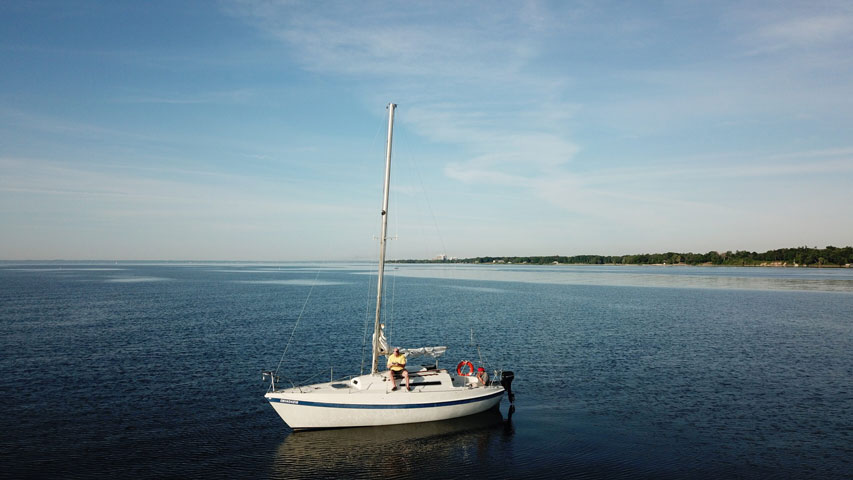
Memories of Sail Repairs, Replacement Sails and FINALLY New Sails
I have had a Tanzer 26 for over 20 years now. The vessel, without much imagination I call The Boat, has served me well and without complaint through yearly cruises on Lake Ontario with my three kids and day sailing with the wife. Did I mention that my wife is a good sport but a definitive lover of a good.

My Need for Cruising Speed Demands a Great Suit of Sails
My Need for Cruising Speed Demands a Great Suit of SailsI like to sail fast mostly in the heavy winds that Lake Ontario throws.
" * " indicates required fields
Thanks for telling us a bit about yourself and your boat. Our team will send you a preliminary quote based on information we have gathered from sailors similar to you.
We will give you a call in order to narrow down the options on your quote and improve the accuracy. If you want us to call you at a specific time, feel free to schedule a time on our calendar!
Thanks for telling us a bit about yourself and your boat. Our team will reach out to offer some suggestions and get started on finding you the perfect sail!
Sailboat Specifications 101: Explained For Beginners
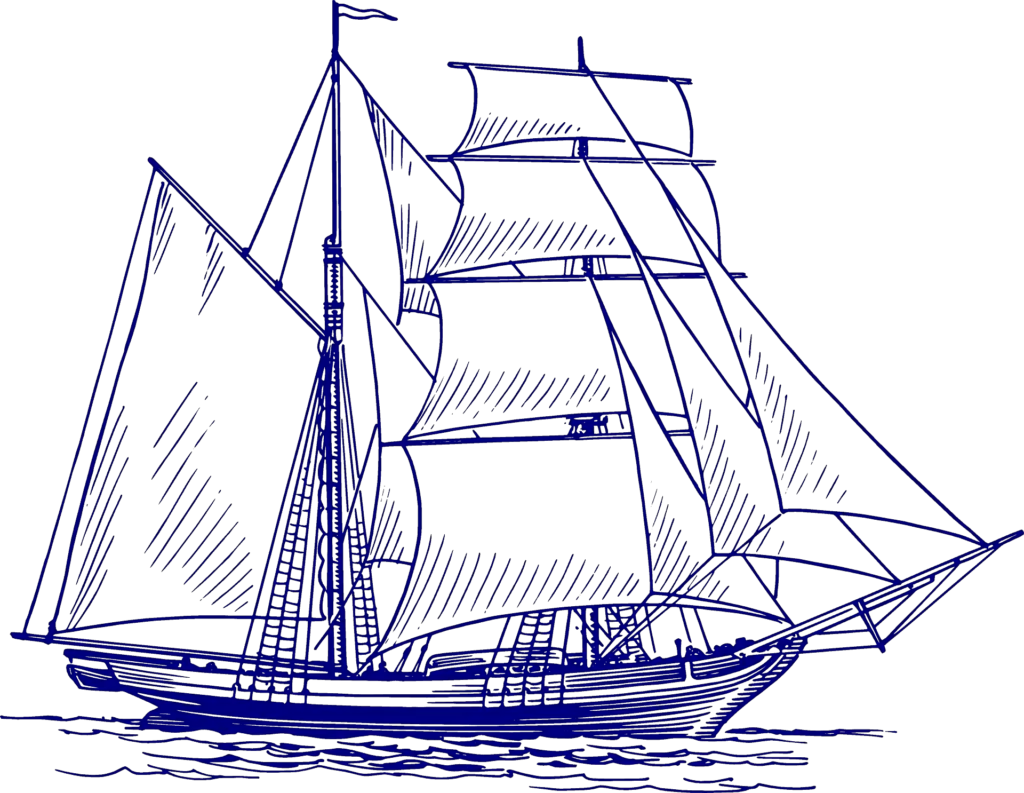
As a newbie to sailing, the sailboat specifics can be overwhelming. Taking time to familiarize yourself with the measurements and vocabulary associated with boats will allow you to be more informed about boats and know which type is right for which activity. You’ll be a better sailor and boater with this knowledge.
Table of Contents
LOA – Length Overall
Length Overall (LOA) is the most common measurement used to describe the size of a sailboat. It refers to the total length of the vessel, from the tip of the bow (front) to the aft end of the stern (back).
LOA is typically measured in feet or meters. This measurement can be useful when comparing boats of similar types, as it gives you an idea of the overall size.
LOD-length on deck
LOD, or Length on Deck, is the measurement of the boat from the tip of the bow to the stern along the deck.
This length does not include any spars, bowsprits, antennas, etc. that are mounted above the main deck.
The difference between LOD and LOA (length overall) is that LOA takes into account any protrusions such as spars and bowsprits. LOD may be shorter than LOA sometimes.
LWL – Load Waterline Length
The LWL or Load Waterline Length is the measurement of the length of a boat at the point where it touches the water.
It is the length of the boat that makes contact with the water and is often shorter than the overall length (LOA) due to the curvature of the hull.
The LWL plays an important role in determining the performance of a sailboat; for example, a longer LWL can help increase stability and reduce drag, allowing the boat to move more efficiently through the water.
The LWL also affects the size of the sail area needed to power the boat. As such, boats with a longer LWL will require larger sails to generate adequate power, while boats with a shorter LWL may need smaller sails.
Beam – The width of the boat
The beam of a sailboat is the maximum width of the hull and is an important measurement for sailing performance.
A wider beam provides more stability on the water and increases the overall sail area. Having a larger sail area will help to increase speed and maneuverability in windy conditions.
It’s important to consider the beam of the boat when deciding what type of sails to use. A boat with a wider beam will require bigger sails, while a boat with a narrower beam will require smaller sails.
Draft – The depth of the boat in the water
Draft measures the distance from the waterline to the lowest point of the boat’s hull when it is fully loaded.
This is important because it affects the boat’s maneuverability, stability, and performance in different sea conditions.
It also affects the sail area of the boat, since a greater draft can provide more stability and lift, allowing for larger sails to be used. Shallow draft boats tend to be able to get into shallower waters than those with deeper drafts.
Full keel vs. modified keel vs. fin keel
The three main types of keels are full, modified, and fin keels.
Full keels are the oldest and most traditional type of keel. They are typically found on heavier displacement boats such as cruisers and larger sailboats.
Full keels provide more stability due to their size and weight, but also create more drag, which can slow down the boat.
Modified keels are a hybrid between full and fin keels. They are often used on boats with moderate displacement, meaning they have a moderate amount of weight.
Modified keels provide a good balance of stability and speed due to their shape and size.
Finally, fin keels are usually found on lighter displacement boats such as racing and performance sailboats.
Fin keels have the least amount of drag, allowing the boat to move faster, but they are not as stable as full or modified keels.
Displacement – The weight of the boat
The displacement of a boat refers to the total weight of the boat, including all of the materials used to construct it. It is usually measured in either metric tonnes or long tons.
The type of displacement your boat has will depend on its size and purpose, with light displacement boats usually being used for day sailing and racing, while moderate and heavy displacement boats are better suited for coastal and ocean cruising.
Light displacement boats are typically quite lightweight, with a hull weight of around 2 tonnes and a total weight of 4 tonnes or less.
These boats are often very fast and agile but can have limited load-carrying capacity due to their light construction.
Moderate displacement boats typically weigh between 4 and 10 tonnes, with a hull weight ranging from 3 to 8 tonnes.
These boats are best suited for coastal cruising and are usually made from heavier materials than light displacement boats. This makes them able to carry a greater load and handle rougher seas with more confidence.
Heavy displacement boats weigh more than 10 tonnes, with a hull weight of up to 15 tonnes.
These boats are built for long-distance ocean cruising and are designed to be sturdy and reliable even in heavy weather. As such, they are usually made from stronger materials than other types of boats and have a much larger load-carrying capacity.
D/L or DLR ratio- Displacement to length ratio
Displacement to length ratio (DLR) is a calculation used to measure the size of a sailboat.
It is determined by dividing the displacement (the weight of the boat) by the waterline length (the length of the boat that is in contact with the water when it is afloat).
The result of this calculation, also known as the DLR, can be used to compare different types of boats or to determine which type of sailboat is most suitable for specific conditions.
The formula for calculating the displacement-to-length ratio is: DLR = (Displacement/2240)/(0.01xLWL)^3 Displacement in pounds, LWL is Waterline Length in feet
Generally, sailboats with higher DLRs tend to have a more rounded hull shape and are better suited to deep-water sailing in heavy weather conditions.
Sailboats with lower DLRs tend to have a more slender hull shape and are better suited to shallow water sailing in light weather conditions.
Ballast is the weight of the boat that is not part of the boat’s structure. This weight can come from a lead, water, or other materials, and it is located in the bottom of the boat to help keep it stable in the water.
The amount of ballast affects the sail area, as more ballast will lower the sail area while decreasing ballast will increase the sail area.
This is because when there is more ballast in the boat, it will be pushed down into the water which reduces the area that a sail can reach. On the other hand, decreasing ballast will allow a sail to extend further.
Ballast is also important for maneuverability and stability; too much ballast and the boat will be sluggish and difficult to turn, while too little ballast could cause the boat to be unstable and even capsize.
Balancing the amount of ballast is key to achieving optimal performance for any type of sailboat.
CSF-Capsize screening formula
The capsize screening formula is a calculation that provides a good indication of the stability of a sailboat. It is the ratio of a boat’s displacement (weight) to its Beam (width).
Capsize ratio formula: Beam / ((Displacement/64.2)1/3) The beam is in feet. Displacement is in pounds
A good capsize ratio is generally considered to be between 1.33 and 2.0, although this can vary depending on the type of boat and its purpose.
A lower capsize ratio indicates that the boat is more stable, as it will be less likely to tip over in strong winds or waves. A higher capsize ratio indicates that the boat is more prone to capsizing.
Motion comfort ratio
Motion comfort ratio (also referred to as “Ted Brewer” ratio) is a measure of the overall stability of a sailboat.
Generally, a boat with a motion comfort ratio greater than 40 is considered stable and a boat with a motion comfort ratio less than 30 is considered unstable.
A boat with a motion comfort ratio between 30-40 is considered moderately stable. The higher the motion comfort ratio, the more comfortable the boat will be in rough waters.
Ted Brewer’s CR formula is: Displacement in pounds/ (.65 x (.7 LWL + .3 LOA) x Beam 1.333 ).
For instance, a boat with an LWL of 35 ft and a displacement of 10,000 lbs would have a motion comfort ratio of 37.5. This would indicate that the boat is moderately stable and should provide an adequate level of comfort in rough waters.
The motion comfort ratio was developed by Ted Brewer and has been used for many years as an indication of a boat’s stability.
It is important to keep in mind, however, that this ratio alone cannot give an accurate picture of how stable a boat is. Other factors such as hull type and keel type should also be taken into account when assessing a boat’s stability.
Ballast to displacement ratio
The ballast-to-displacement ratio is a measure of how much ballast is needed in relation to the weight of the boat.
The higher the ballast-to-displacement ratio, the more stable the boat will be and the less likely it will be to capsize.
the ballast-to-displacement ratio is important for ensuring the boat is adequately balanced and has good performance when sailing.
It is especially important for boats that have large sail areas, as larger sail areas require more ballast to keep the boat steady.
When considering a boat’s ballast-to-displacement ratio, keep in mind that a ratio of 40-50% is generally considered to be optimal. Any higher than that may be too much, while any lower may not be enough.

What Do Boat Measurements Mean? 11 Terms Explained!
Boat measurements are crucial for maritime safety, efficiency, and compatibility. Navigating these measurements is vital for manufacturers and boating enthusiasts. Proper understanding ensures vessel selection, marina compliance, and safe navigation.
11 Main Boat Measurement Terms
- Length Overall (LOA) : The total length from the bow to the stern. It determines mooring space, marina fees, and navigation in confined waters. For example, a boat with a 30-foot LOA needs a slightly longer berth.
- Length on Deck (LOD) : Measures the hull’s horizontal length, excluding extensions like bow sprits. It provides a more accurate measurement of usable space. A boat might have a 35-foot LOA but a 30-foot LOD due to a 5-foot bow sprit.
- Beam : The width at the widest point, affecting stability and maneuverability. For instance, a boat with a 10-foot beam is more stable but less maneuverable than one with an 8-foot beam.
- Draft : The minimum depth required for the boat to float. A sailboat with a 6-foot draft cannot navigate waters less than 6 feet deep.
- Displacement : The weight of water displaced by the hull, reflecting the boat’s weight when loaded. A boat displacing 5 tons handles differently than one displacing 2 tons.
- Freeboard : The distance from the waterline to the upper deck, indicates how much of the boat is above water. A boat with 4 feet of freeboard handles choppy water better than one with 2 feet.
- Deadrise : The hull’s angle relative to a flat surface. A higher deadrise (sharp angle) cuts through waves better. A boat with a 20-degree deadrise performs better in rough water than one with a 10-degree deadrise.
- Air Draft : The height from the waterline to the highest fixed point. Important for bridge clearances. A sailboat with a 50-foot mast must consider bridge heights.
- Gross Tonnage : Volume measurement for large vessels, based on total internal space. For example, a cargo ship with 50,000 gross tonnage has a large capacity.
- Ballast : Weight added low in the boat for stability. A sailboat with 2,000 pounds of ballast is more stable than one with 1,000 pounds.
- Waterline Length (LWL) : Length at the waterline, affects speed and stability. A boat with a 25-foot LWL is generally faster than one with a 20-foot LWL.
How to Measure a Boat Hull
- Length Overall (LOA) : Measure from the furthest point forward to the furthest point aft.
- Length on Deck (LOD) : Measure the deck length, excluding overhangs.
- Waterline Length (LWL) : Measure at the waterline.
- Beam : Measure the widest part of the hull.
- Draft : Measure from the waterline to the lowest part of the hull.
- Freeboard : Measure from the waterline to the upper edge of the hull.
- Deadrise : Measure the angle between the hull bottom and a horizontal plane.
- Hull Depth : Measure from the deepest point of the hull to the top of the deck.
Coast Guard Boat Length Measurement
The U.S. Coast Guard measures boat length using the Length Overall (LOA) method, from the bow’s tip to the stern’s end, including structural parts but excluding removable attachments. This measurement is crucial for regulatory and safety reasons, influencing boating laws and safety requirements.
- Recent Posts
- Report: Yang Ming’s YM Mobility Explosion at Ningbo-Zhoushan Port – August 9, 2024
- Understanding Drillships: Types, Key Features and Advancements – August 1, 2024
- Sustainable and Luxurious: Discovering Split’s Yachting Paradise – April 26, 2024
About the author
I worked as an officer in the deck department on various types of vessels, including oil and chemical tankers, LPG carriers, and even reefer and TSHD in the early years. Currently employed as Marine Surveyor carrying cargo, draft, bunker, and warranty survey.
Leave a Reply Cancel reply
Your email address will not be published. Required fields are marked *
Save my name, email, and website in this browser for the next time I comment.
Latest posts

What Are AGVs? Automation Becoming Increasingly Common in Seaports
What are AGVs? Automated guided vehicles can minimize the troubles of manual operations and enhance seaport operations.
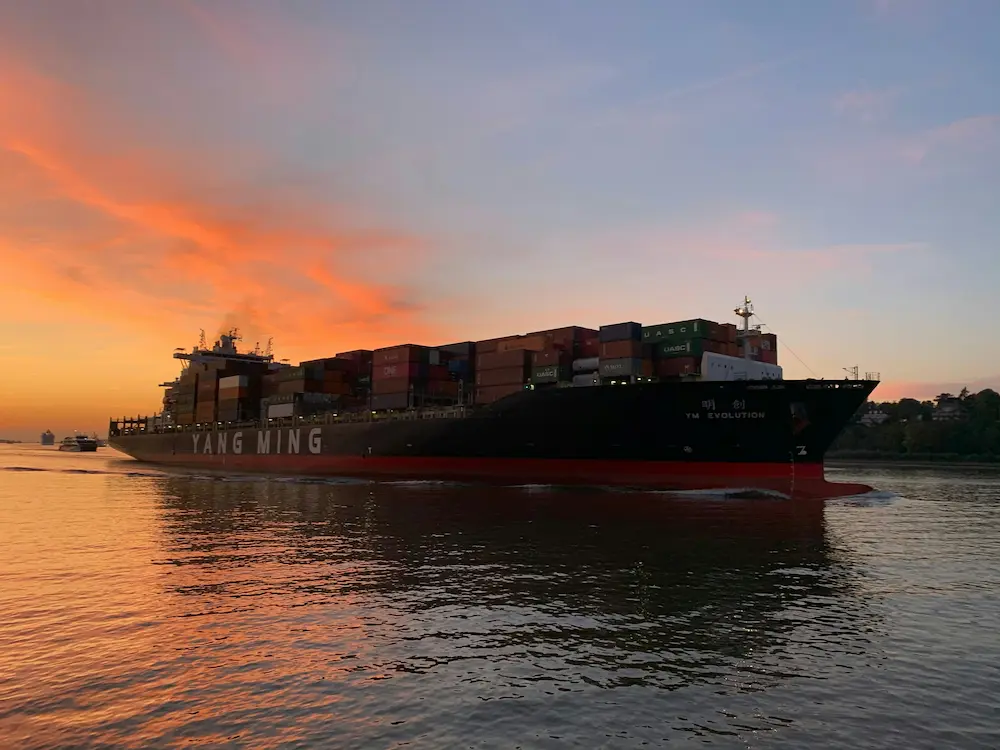
Report: Yang Ming’s YM Mobility Explosion at Ningbo-Zhoushan Port
A massive explosion occurred on the container ship YM Mobility while it was berthed at the Ningbo-Zhoushan Port in China

Maintaining Watertight Integrity on Boat Hatches
Good watertight integrity on boat hatches is paramount to keeping the ship afloat and minimizing damage at all costs.
Great choice! Your favorites are temporarily saved for this session. Sign in to save them permanently, access them on any device, and receive relevant alerts.
- Sailboat Guide
Calculations
Sail area / displacement ratio.
A measure of the power of the sails relative to the weight of the boat. The higher the number, the higher the performance, but the harder the boat will be to handle. This ratio is a "non-dimensional" value that facilitates comparisons between boats of different types and sizes. Read more.
SA/D = SA ÷ (D ÷ 64) 2/3
- SA : Sail area in square feet, derived by adding the mainsail area to 100% of the foretriangle area (the lateral area above the deck between the mast and the forestay).
- D : Displacement in pounds.
Ballast / Displacement Ratio
A measure of the stability of a boat's hull that suggests how well a monohull will stand up to its sails. The ballast displacement ratio indicates how much of the weight of a boat is placed for maximum stability against capsizing and is an indicator of stiffness and resistance to capsize.
Ballast / Displacement * 100
Displacement / Length Ratio
A measure of the weight of the boat relative to it's length at the waterline. The higher a boat’s D/L ratio, the more easily it will carry a load and the more comfortable its motion will be. The lower a boat's ratio is, the less power it takes to drive the boat to its nominal hull speed or beyond. Read more.
D/L = (D ÷ 2240) ÷ (0.01 x LWL)³
- D: Displacement of the boat in pounds.
- LWL: Waterline length in feet
Comfort Ratio
This ratio assess how quickly and abruptly a boat’s hull reacts to waves in a significant seaway, these being the elements of a boat’s motion most likely to cause seasickness. Read more.
Comfort ratio = D ÷ (.65 x (.7 LWL + .3 LOA) x Beam 1.33 )
- D: Displacement of the boat in pounds
- LOA: Length overall in feet
- Beam: Width of boat at the widest point in feet
Capsize Screening Formula
This formula attempts to indicate whether a given boat might be too wide and light to readily right itself after being overturned in extreme conditions. Read more.
CSV = Beam ÷ ³√(D / 64)
The theoretical maximum speed that a displacement hull can move efficiently through the water is determined by it's waterline length and displacement. It may be unable to reach this speed if the boat is underpowered or heavily loaded, though it may exceed this speed given enough power. Read more.
Classic hull speed formula:
Hull Speed = 1.34 x √LWL
Max Speed/Length ratio = 8.26 ÷ Displacement/Length ratio .311 Hull Speed = Max Speed/Length ratio x √LWL
- About Sailboat Guide
©2024 Sea Time Tech, LLC
This site is protected by reCAPTCHA and the Google Privacy Policy and Terms of Service apply.


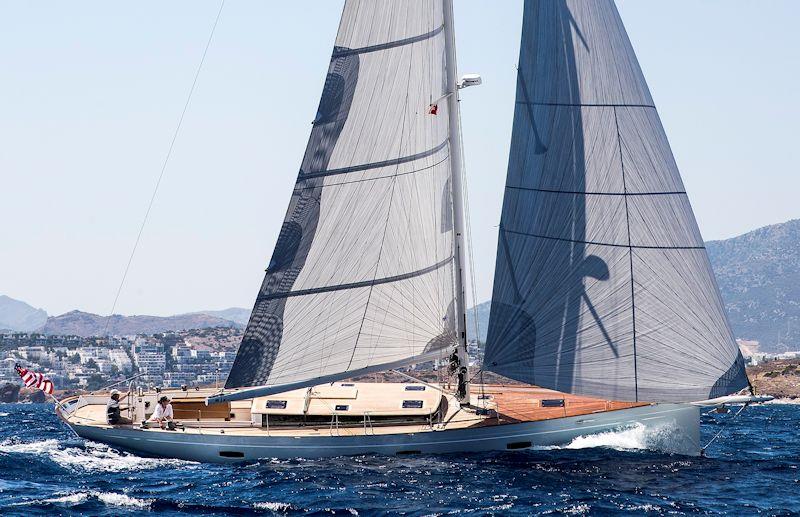
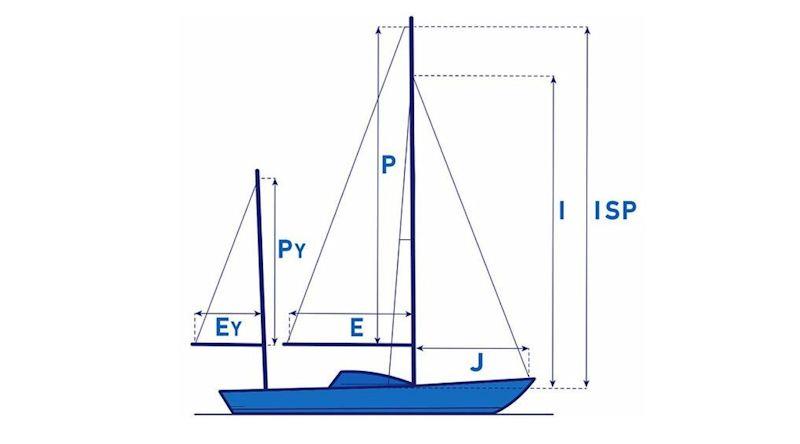
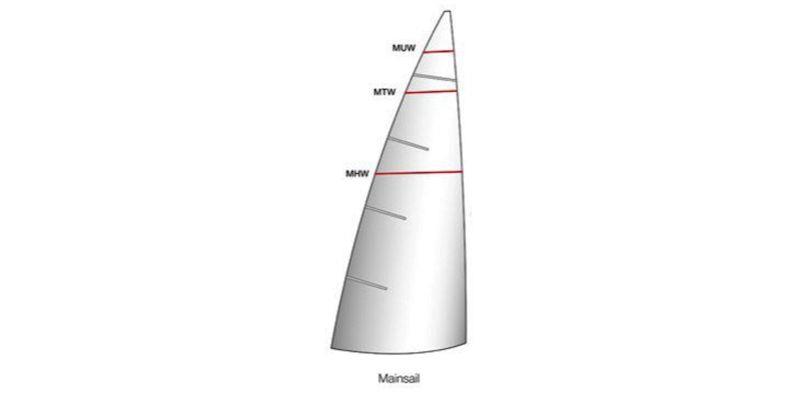
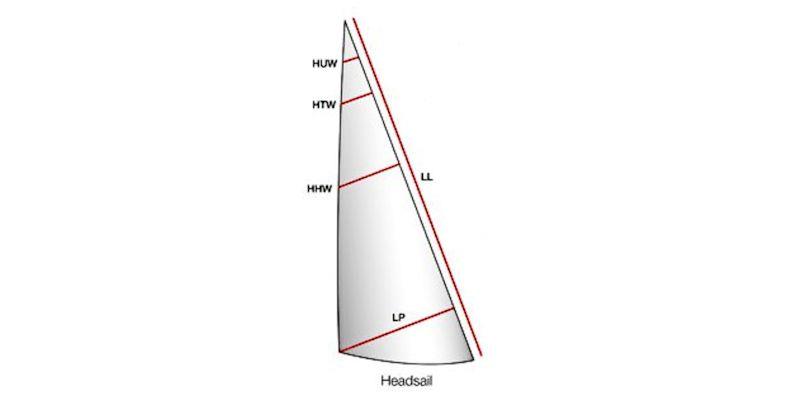
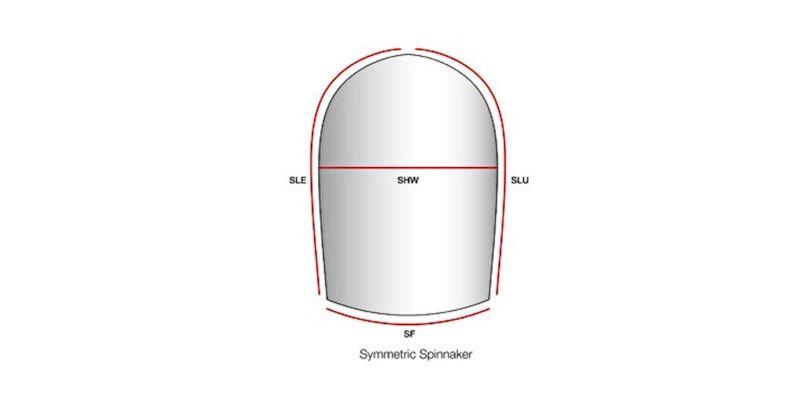
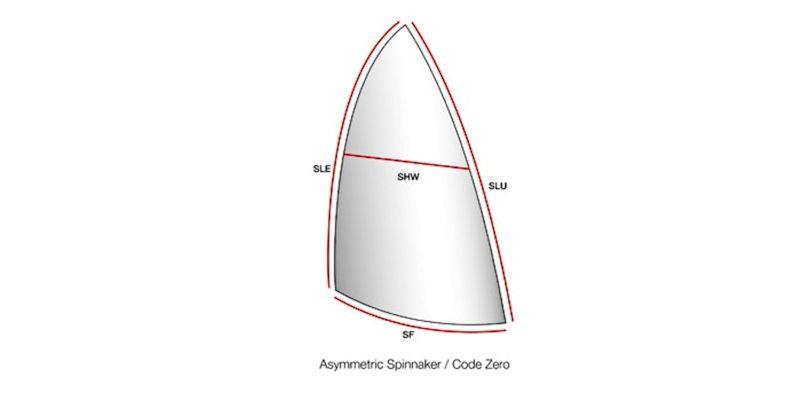
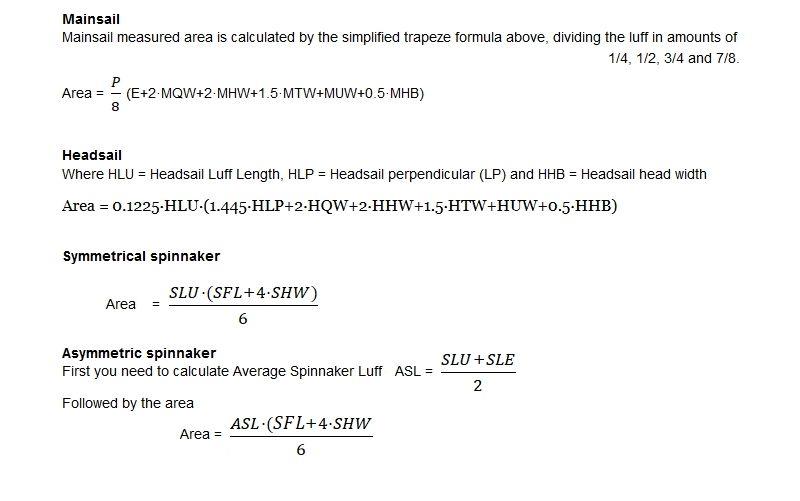

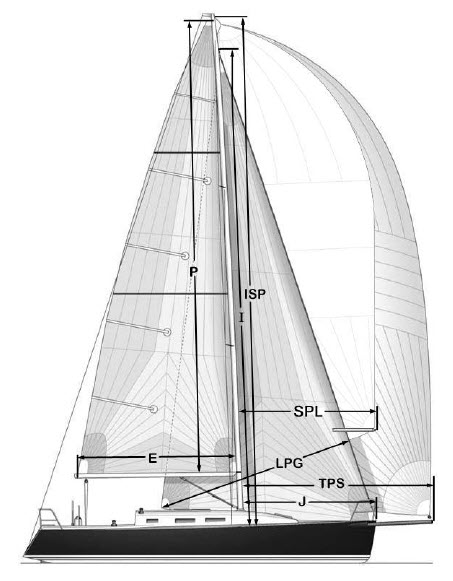
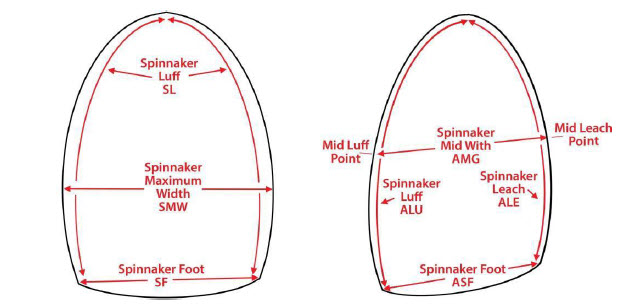
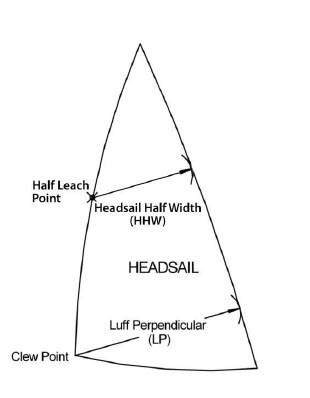
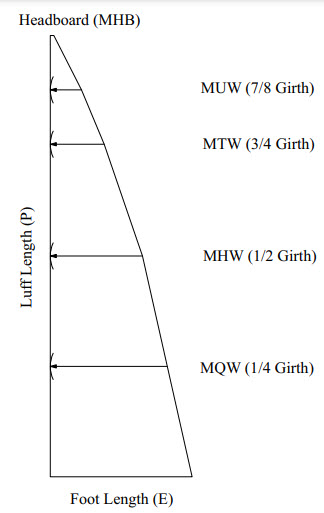
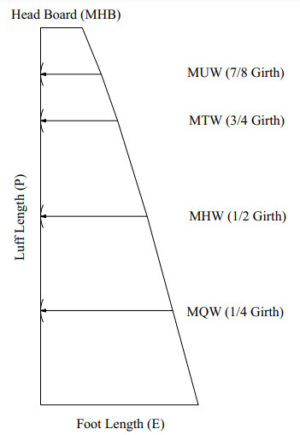
IMAGES
COMMENTS
Yacht designers need these sail dimensions to calculate thought provoking stuff such as the sail-area/displacement ratios of their creations, and sailmakers need them before they put scissors to sailcloth.
Rig Dimensions. The following abbreviations are often used to describe various measurements on a sailboat. Precise technical definitions exist for each abbreviation, but the following is a list of simple descriptions. LOA. Length Overall - overall tip-to-tip length of the boat. LWL.
Design ratios tell a story, but to get the real picture about a vessel, sail area, displacement, and ballast deserve a longer look.
However, there are some differences in how some sailors describe these dimensions. Here is how we define them at North Sails. I - Height of Foretriangle. Elevation of Forestay, measured down to elevation of main shrouds at sheer line. J - Base of Foretriangle. Horizontal distance measured from front face of mast at deck to position of ...
Sailboat Sail Dimensions With those basic terms out of the way, it's time to look at a few things that sailmakers consider when designing a set of sails. The most significant limits placed on the sailmaker come from the boat itself. Many makes and models of boats have their sail specifications online. It's essential to break out the tape measure and measure your boat-if only to confirm ...
SAIL DIMENSIONS: "SLE""SGM""SGF""SPL""H""WPL"Rig foretriangle height measured along the foreside of the mast fro. the main deck datum to the top of the jib halyard sheave. The height of the deck used as datum for "I" measurement shall be ta.
By using IMS, the complete boat can be measured, including the hull shape, appendages, propeller, stability, rig and sails. IMS uses WS Equipment Rules of Sailing (ERS) and its definitions are amended only for items specific to offshore boats. Same measurement procedures may be used in measurements of monohulls, multihulls or superyachts.
SAILS & SAIL MEASUREMENT 96 . 16. SAIL AREA MEASUREMENT 115 ... GLOSSARY AND ABBREVIATIONS 137 . 19. CONVERSION FACTORS 149 . 20. MASS DENSITY OF SOME SUBSTANCES 150 . ISAF International Measurer's Manual - Page 4 1 MEASURERS . This section considers the role of measurers, their qualifications, appointment, conduct and responsibilities and ...
The following rig dimensions designated by " I ", " J ", " P ", and " E " are needed to produce a price quote. They are convenient names to use because they are short and are understood throughout sailmaking…. " P " is the luff length of the main-sail, measured along the aft face of the mast from the top of the boom to the ...
Sailboat Rig Specs: Precision Sails Defined The above infographic shows how Precision Sails label sailboat rig specifications. Continue reading below to see definitions and basic how-to tips on how to measure them below. Rig specs are important for designing a sail suited for your applications and boat.
Beam - The width of the boat The beam of a sailboat is the maximum width of the hull and is an important measurement for sailing performance. A wider beam provides more stability on the water and increases the overall sail area. Having a larger sail area will help to increase speed and maneuverability in windy conditions.
Guide to PHRF Sail Measuring.docx 2/5 Revision 2020-06-24 HHW (Headsail Half Width)is defined as the shortest distance between the half leech point and the luff.
The term sailboat includes many different sizes, shapes, and hull types. Here's how to identify most of the common ones.
11 Main Boat Measurement Terms. Length Overall (LOA): The total length from the bow to the stern. It determines mooring space, marina fees, and navigation in confined waters. For example, a boat with a 30-foot LOA needs a slightly longer berth. Length on Deck (LOD): Measures the hull's horizontal length, excluding extensions like bow sprits.
Sail Area / Displacement Ratio A measure of the power of the sails relative to the weight of the boat. The higher the number, the higher the performance, but the harder the boat will be to handle. This ratio is a "non-dimensional" value that facilitates comparisons between boats of different types and sizes. Read more. Formula 19.17 <16: under ...
How to choose a boat - yacht measurements explained There's a standard set of specifications that appear in boatbuilders' sales brochures and on yachtbrokers' websites: LOA, LWL, displacement, sail area, ballast ratio, D/L, SA/D and so on. Most buyers rely on these to some extent, to read between the lines of the marketing literature, but the figures quoted aren't actually as clear ...
Sail Measurement Assistance. Boat: Every boat has maximum sail dimensions that cannot be exceeded. They are defined as I, J, P and E, (also Py and Ey for Ketchs and Yawls). Unless you have existing sails to use as a reference, it is always best to physically measure the boat and not rely totally on manufacturers specifications.
Please note that the measurement rules for rig dimensions vary from class rule to class rule and from measurement rule to measurement rule. Many yacht designers use different definitions as well. These definitions are general enough to provide guidelines to approximate your sail area.
I know that these are the dimensions of my sail plan but what do they actually measure? And other than when I am ordering a new sail, when will I use this info?
Basic main and headsail sail areas can be calculated from simple rig data whereas for a more accurate sail area calculations you need detailed measurements of your sail which you can either measure yourself or ask your sailmaker to supply.
The International Measurement System (IMS) is a set of rules that define what and how is measured on a boat. It is used by the Offshore Racing Congress (ORC) as a measurement platform on its ORC Rating Systems (ORC International and ORC Club). In this article, we deep dive into sails from the IMS perspective. This content is for Subscriber, Advanced (monthly), Advanced (annual), Pro (monthly ...
The guide is intended to help measurers and others understand the ISAF Equipment Rules of Sailing for sail measurement and associated racing rules and to assist in achieving correct, accurate and consistent measuring of sails. Should a measurer be in any doubt as to the application of or compliance with a rule or measurement instruction, the ...
Boat Measurements & Definitions. It is recommended that the measurer have a good quality 100-foot tape measure with a loop fitting that can be connected to a halyard shackle. The tape should be either metal or fiberglass backed so that it does not stretch. A plumb bob and a level are also useful. All measurements are in decimal fractions of a ...